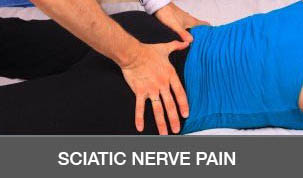Relief for sciatic nerve pain
Getting relief from Sciatic Nerve Pain becomes super important when you have this type of pain. The pain is generally one of the worst conditions of the lower back and the pain is very intense. The pain is described as a burning hot poker going down the back of the leg. I have seen the pain shoot a short distance into the upper thigh area or all the way to the foot. The sciatic nerve originates from the lumbar spine at levels L2 down to L5 and S1 or S2 segments. This nerve is about the size of your little finger, and carries impulses to the lower leg and foot. With sciatic pain, you can have numbness, weakness, or pain in the lower leg and foot. That pain could feel disconnected from the pain in the lower back.
In order to understand how to relieve sciatic pain, you need to know where the pain is actually coming from. There are several sources of impingement that can cause the sciatic type of pain. The first and most hazardous is a space occupying lesion in the low back. A space occupying lesion in the lumbar neural canal can be a secondary cancerous tumor. Or it can be a disc bulge. Both of these possibilities need to be considered when dealing with sciatic pain. Another possibility is what has been called pseudo sciatica. This condition stems from the hip rotator muscle like the piriformis muscle. The sciatic nerve sometimes goes through the muscle belly of the piriformis can pinch the sciatic nerve. An easier condition to work with, but is no less painful for the patient.
Relieving Sciatica
Relieving the pain should begin with an examination by a physician trained in neuromuscular pain. A neurologist or orthopedist can easily order the tests (MRI) to diagnose the presence of a space occupying lesion (disc bulge or tumor). The chiropractic physician is also highly adept at identification of these types of lesions also. Chiropractors work with the spinal joints to relieve the pressure on a disc, or relieve the trigger points in the hip rotator muscles.
Your medical doctor will prescribe muscle relaxers and pain medications that can help reduce the spasm in the muscles. Then the body can heal the condition on its own. Home remedies include ice for inflammation, heat on the side of the pain to relieve muscle spasm, massage lower back or buttocks, or specific stretching exercises.
Sciatic Nerve pain can be extremely debilitating. If you are trying to relieve the pain with home remedies, try it but if they don’t give you results within a day, consult a physician to make sure it’s not a more serious problem. It has been said that this condition will resolve on its own in four to six weeks, but can you wait that long to get relief? Most chiropractors and orthopedic surgeons will look for the underlying source of the problem and not simply allow an adaptation of the body to bypass the damage that is done. Pain is present for a reason; please consult someone who can help you resolve the cause.

